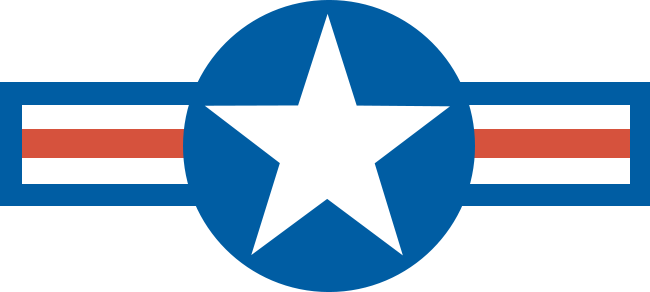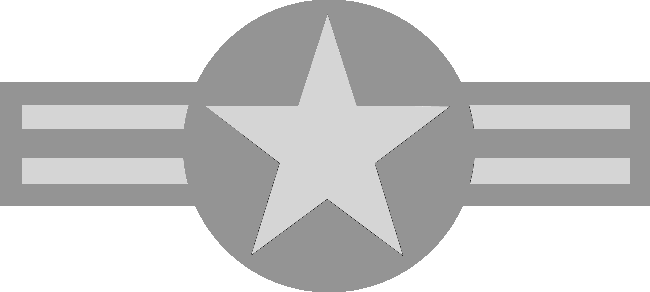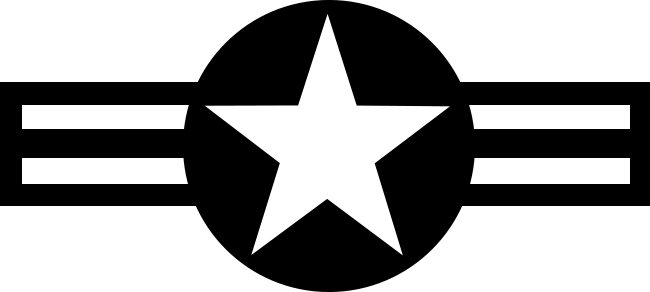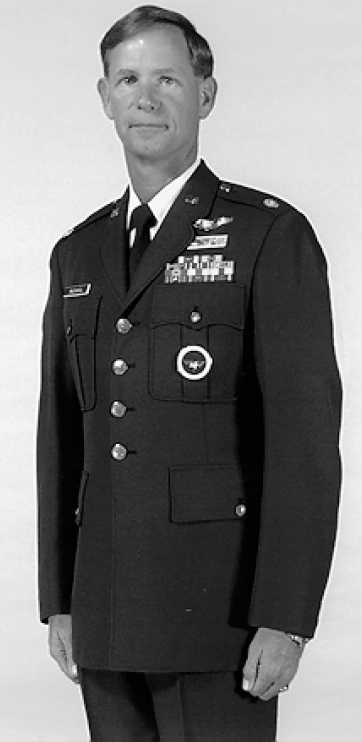United States Air Force
From Themarshallwiki
United States Air Force (USAF) is the aerial warfare branch of the armed forces of the United States and one of the seven uniformed services of the United States. Initially born as the United States Army Air Corps, the USAF was formed as a separate branch of the military on September 18, 1947. It was the last branch of the U.S. military to be formed.
Its role is "To provide sovereign options for the defense of the United States and its global interests. To fly and fight in Air, Space, and Cyberspace"

Seal of the United States Department of the Air Force
Contents
|
Organisation
The USAF is part of the Department of the Air Force, which is in turn part of the Department of Defense. The civilian leader is the USAF is the Secretary of the Air Force, who reports to the Secretary of Defense. The military leader of the USAF is the Chief of Staff, United States Air Force, who is a member of the Joint Chiefs of Staff, and reports to the Secretary of the Air Force.
The USAF is organised into several Major Commands to carry out its various functions.
The USAF has the following major commands:
 Headquarters, United States Air Force
Headquarters, United States Air Force
Tactical Air Command
 First Air Force
First Air Force
 Second Air Force
Second Air Force
 Fifth Air Force
Fifth Air Force
 Ninth Air Force
Ninth Air Force
 Twenty-First Air Force
Twenty-First Air Force
 Strategic Air Command
Strategic Air Command
 Eighth Air Force (Strategic Bombers)
Eighth Air Force (Strategic Bombers)
 Fifteenth Air Force (Reconnaissance)
Fifteenth Air Force (Reconnaissance)
 Twentieth Air Force (ICBMs)
Twentieth Air Force (ICBMs)
 Military Airlift Command
Military Airlift Command
 Twelfth Air Force
Twelfth Air Force
 Fourteenth Air Force
Fourteenth Air Force
 Eighteenth Air Force
Eighteenth Air Force
Air Force Special Operations Command
 Twenty-Third Air Force
Twenty-Third Air Force
 Air Force Cyber Command
Air Force Cyber Command
 Air Force Space Command
Air Force Space Command
 Air Education & Training Command
Air Education & Training Command
 Nineteenth Air Force
Nineteenth Air Force
 Air Force Material Command
Air Force Material Command
 Air Force Reserve Command
Air Force Reserve Command
 Fourth Air Force
Fourth Air Force
 Tenth Air Force
Tenth Air Force
 Twenty-Second Air Force
Twenty-Second Air Force
 Pacific Air Forces
Pacific Air Forces
 Fifth Air Force (Japan)
Fifth Air Force (Japan)
 Seventh Air Force (Korea)
Seventh Air Force (Korea)
 Eleventh Air Force (Alaska)
Eleventh Air Force (Alaska)
 Thirteenth Air Force (Hawaii)
Thirteenth Air Force (Hawaii)
 United States Air Forces in Europe
United States Air Forces in Europe
 Third Air Force (Northern Europe, Western Europe)
Third Air Force (Northern Europe, Western Europe)
 Sixteenth (Southern Europe)
Sixteenth (Southern Europe)
 Seventeenth Air Force (South West Europe, North Africa)
Seventeenth Air Force (South West Europe, North Africa)
 Air National Guard
Air National Guard
- 50 States
- 2 Territories
- District of Columbia
- Air Forces not attached to a USAF Major Command
 Sixth Air Force (US Southern Command)
Sixth Air Force (US Southern Command)
 United States Central Command Air Forces (US Central Command)
United States Central Command Air Forces (US Central Command)
The role of most of these operational commands is to sustain, and train forces, and to provide forces to the Unified Combatant Commands. Under each Major Command, there are Numbered Air Forces.
The Numbered Air Forces in the functional commands hold units for deployment for the regional commands. The Numbered Air Forces in the Regional Commands hold some, or all of the USAF units in that Command. These units are not permanently assigned, for example, the 48th Tactical Fighter Wing is under the command of the Third Air Force in USAFE, but it is under the permanent jurisdiction of Tactical Air Command's Fifth Air Force. Some Regional Major Commands have multiple numbered air forces. PACAF has four numbered air forces.
Only Commands with flying units have Numbered Air Forces. Air Force Space Command, for example has no air forces. Likewise, for Commands with flying and non-flying units, only flying units are included in Numbered Air Forces. Numbered Air Forces vary greatly in size.

Logo of the US Air Force
Flying Units and Equipment

US Air Force roundels, 1917 - present day
- 5/17-2/18 - Aviation Section, U.S. Signal Corps
- 2/18-8/19 - Aviation Section, U.S. Signal Corps, Division of Military Aeronautics, U.S. Army Air Service
- 8/19-5/42 - U.S. Army Air Service, U.S. Army Air Corps, U.S. Army Air Forces
- 5/42-6/43 - U.S. Army Air Forces
- 6/43-9/43 - U.S. Army Air Forces
- 9/43-1/47 - U.S. Army Air Forces
- 1/47- - U.S. Army Air Forces, U.S. Air Force
Strategic Air Command
Strategic Air Command (SAC) is responsible for the USAF's strategic bombers, intercontinental ballistic missiles, and strategic reconnaissance aircraft. It also operates strategic command aircraft such as the E-4 National Emergency Airborne Command Post. Although it provides aircraft and aircrews to all Unified Combatant Commands, it normally reports to United States Strategic Command.
Strategic Bombers
- 4 Squadrons of Northrop Grumman B-2 Spirit
- 5 Squadrons of Rockwell B-1B Lancer
- 5 Squadrons of Boeing B-52H Stratofortress
- 7 Squadrons of Boeing B-52G Stratofortress
Intercontinental Ballistic Missiles
- 6 Squadrons of LGM-118 Peacekeeper
- 9 Squadrons of LGM-134 Midgetman
- 25 Squadrons of LGM-30G Minuteman III
Strategic Reconnaissance Aircraft
- 2 Squadrons of Lockheed U-2R
- 1 Squadron of Boeing RC-135
- 2 Squadrons of Northrop Grumman RQ-17 Global Hawk
- 2 Boeing WC-135W Constant Phoenix
Command and Control Aircraft
- 25 Boeing EC-135
- 11 EC-135C for SAC (Looking Glass)
- 4 EC-135H for U.S. European Command (Silk Purse)
- 5 EC-135J/P for U.S. Atlantic Forces (Scope Light)
- 5 EC-135J/P for U.S. Pacific Command (Blue Eagle)
- 4 Boeing E-4B NEACP
Tankers
- 3 Squadrons of McDonnell Douglas KC-10 Extender
- 18 Squadrons of Boeing KC-135E/R/T Stratotanker
Conversion Trainers
- 1 Bomber Training Squadron (B-1B/B-2)
- 1 Squadron of TB-52H Stratofortress
Tactical Air Command
Tactical Air Command is repsonsible for battlefield-level (tactical) air combat to include air superiority (offensive and defensive counterair), light bombardment, tactical nuclear strike, tactical reconnaissance, close air support of ground troops, and battlefield air interdiction of enemy forces. It is also responsible for tactical ballistic missiles and tactical cruise missiles, although the latter role in the 1980s and 1990s was often delegated to United States Air Forces in Europe (USAFE) and Pacific Air Forces (PACAF). TAC also assists AFRC and the ANG in the air defence of the continental United States.
Strike Aircraft
- 2 Squadrons of Lockheed F-117 Nighthawk
- 5 Squadrons of Northrop Grumman FB-23 Black Widow II [1],[2]
- 18 Squadrons of General Dynamics F-111
Tactical Fighters
- 10 Squadrons of Lockheed Martin/Boeing F-22A/B Raptor
- 35 Squadrons of McDonnell Douglas F-15C/D Eagle
- 27 Squadrons of McDonnell Douglas F-15E Stike Eagle
- 17 Squadrons of Lockheed Martin F-16C/D Fighting Falcon (Block 50)
- 18 Squadrons of Lockheed Martin F-16C/D Fighting Falcon (Block 40)
- 17 Squadrons of Lockheed Martin F-16C/D Fighting Falcon (Block 30)
Attack Aircraft/Counter-Insurgency/FAC
- 30 Squadrons of Fairchild-Republic A-10C Thunderbolt II
- 9 Squadrons of Beechcraft AT-6 Texan II
- 7 Squadrons of Cessna AT-37F Dragonfly
- 1 Squadrons of Beechcraft OT-6 Texan II
- 2 Squadron of Cessna OT-37F Dragonfly
Missiles
- 6 Squadrons of BGM-109H Gryphon Ground Launched Cruise Missiles
- 8 Squadrons of MGM-31C Pershing II Intermediate Range Ballistic Missiles
Unmanned Aerial Vehicles
- 5 Squadrons of General Atomics MQ-16 Predator
- 1 Squadron of General Atomics MQ-18 Reaper
Electronic Warfare/Surveillance Aircraft
- 2 Squadrons of Grumman/General Dynamics EF-111A Raven
- 3 Squadrons of McDonnell Douglas EF-15E Strike Eagle
- 6 Squadrons of Lockheed Martin EF-16C/D Fighting Falcon (Block 50)
- 2 Squadron of Northrop Grumman E-8 Joint STARS
- 4 Squadrons of Boeing E-3 Sentry
Aggressors
- 1 Squadron of McDonnell Douglas F-15A/B Eagle
- 3 Squadrons of Lockheed Martin F-16A/B Fighting Falcon
- 2 Squadrons of Northrop F-5E Tiger II
United States Air Force Thunderbirds
- 6 Lockheed Martin F-16C Fighting Falcons
- 2 Lockheed Martin F-16D Fighting Falcons
Operational Conversion Training
- 1 Squadron of Lockheed Martin F-22 Raptor
- 3 Squadrons of McDonnell Douglas F-15C/D Eagle
- 2 Squadrons of McDonnell Douglas F-15E Strike Eagle
- 1 Squadron of Lockheed Martin F-35A Lightning II
- 5 Squadrons of Lockheed Martin F-16C/D Fighting Falcon (Block 15/25)
Air Force Special Operations Command
Air Force Special Operations Command is composed of highly trained, rapidly deployable Airmen who are equipped with specialized aircraft. These forces conduct global special operations missions ranging from precision application of firepower, to infiltration, aviation foreign internal defense, exfiltration, resupply and refueling of SOF operational elements. The command's special tactics squadrons combine combat controllers, special operations weathermen, pararescuemen, and combat rescue officers to form versatile SOF teams. The command also possesses forces intended specifically for irregular warfare, or foreign internal defense. This force provides a more or less comprehensive counter-insurgency aviation capability as opposed to the large, dedicated light attack/COIN force in Tactical Air Command. In addition, the attack aircraft provide cover for Combat Search and Rescue missions, in the manner of the Douglas A-46 Skyraider in Vietnam. AFSOC's unique capabilities include airborne radio and television broadcast for psychological operations, as well as combat aviation advisors to provide other governments military expertise for their internal development.
- 1 Squadron of Lockheed Martin AC-130H Spectre
- 1 Squadron of Lockheed Martin AC-130U Spectre
- 2 Squadrons of Lockheed Martin MC-130H Combat Talon II
- 2 Squadrons of Lockheed Martin MC-130P Combat Shadow
- 2 Squadrons of Lockheed Martin MC-130W Combat Spear
- 4 Squadrons of Lockheed Martin HC-130 Hercules
- 1 Squadron of Lockheed Martin EC-130E Commando Solo II
- 1 Squadron of Lockheed Martin EC-130H Compass Call
- 1 Squadron of Lockheed Martin EC-130E Airborne Battlefield Command and Control Center (ABCCC)
- 2 Squadrons of Sikorsky MH-53J/M Pave Low
- 4 Squadrons of Sikorsky HH-60G Pave Hawk
- 2 Squadrons of de Havilland Canada CV-2C Turbo Caribou
- 1 Squadron of de Havilland Canada CV-7 Buffalo
- 2 Squadrons of Cessna U-27A Caravan
- 5 Squadrons of Beechcraft AT-6 Texan II
Military Airlift Command
Military Airlift Command (MAC) is a United States Air Force major command.
In addition to the primary transport aircraft units, MAC also served as the headquarters for several independent "services." Air Weather Service (AWS), Air Rescue Service (ARS which later became Aerospace Rescue Recovery Service, ARRS), Special Airlift Mission (SAM), Air Photographic and Charting Service (APCS), and the Aeromedical Transport Wing (AMTW).
Tactical Transports
- 28 Squadrons of Lockheed C-130E/H/J Hercules
Strategic Transports
- 9 Squadrons of McDonnell Douglas C-17 Globemaster III
- 6 Squadrons of Lockheed Martin C-5M Galaxy
- 9 Squadrons of Lockheed C-141C Starlifter
Executive Transports
- 2 Gulfstream C-20Gulfstream III
- 2 Squadrons of LearJet C-21
- 10 Gulfstream C-37 Gulfstream V
- 8 Boeing C-40 Clipper
- 3 Boeing C-32
- 2 Boeing VC-25 (Air Force One)
- 3 Squadrons of Beech C-12 Huron
Conversion Training
- 1 Composite Airlift Training Squadron
- 1 Squadron of C-130 Hercules
Air Education & Training Command
AETC's mission is to "develop America's Airmen today... for tomorrow." The command recruits, trains, and educates Airmen for the United States Air Force.
ATEC conducts virtually all USAF training, from basic recruit training to fast jet training.
Flying Training
- 23 Squadrons of Northrop T-38 Talon
- 21 Squadrons of Beechcraft T-6 Texan II
- 21 Squadrons of Cessna T-37 Tweet
- 9 Squadrons of Raytheon T-1 Jayhawk
- 1 Squadron of Boeing T-43
Flight Screening
- Initial Flight Screening
- Contract to Doss Aviation
Air Force Space Command
Air Force Space Command is focussed on space surveillance, missile warning and defence, the US military space program including operating satellites, and launching military satellites.
- Ground-Based Midcourse Defense
- 6 Squadrons of Ground Based Interceptor missiles
Air Force Material Command
Air Force Materiel Command (AFMC) is a major command of the United States Air Force. AFMC was created July 1, 1992 through the reorganization of Air Force Logistics Command and Air Force Systems Command. Air Force Materiel Command conducts research, development, test and evaluation, and provides the acquisition management services and logistics support necessary to keep Air Force weapon systems ready for war. The command develops, acquires and sustains the aerospace power needed to defend the United States and its interests for today and tomorrow. This is accomplished through management, research, acquisition, development, testing and maintenance of existing and future weapons systems and their components.
Its main testing unit is the Air Force Flight Test Center. It consists of the 412th Test Wing, based at Edwards Air Force Base, California and a Base Wing to provide support.
AFMC operates examples of almost every aircraft used by the US Air Force. Aircraft operated permanently by AFMC are as follows:
- Northrop T-38 Talon
- Boeing C-135 Stratolifter (mostly MKC-135)
- Boeing C-137 Stratoliner
- North American T-39 Sabreliner
Aircraft currently being tested include:
- Boeing AL-1 Airborne Laser
- Lockheed Martin F-22 Raptor
- Lockheed Martin F-35 Lightning II
Air Force Reserve Command
The Air Force Reserve Command is a federal reserve of the US Air Force.
- 3 Squadrons of McDonnell Douglas F-15A/B Eagle
- 4 Squadrons of Lockheed Martin F-16 Fighting Falcon (Block 30)
- 5 Squadrons of Fairchild-Republic A-10 Thunderbolt II
- 5 Squadrons of Lockheed C-130E/H Hercules
- 2 Squadrons of Lockheed Martin C-5 Galaxy
- 8 Squadrons of Bell UH-1N Iroquois
- 3 Squadrons of Boeing KC-135 Stratotanker
- 1 Squadron of Lockheed Martin WC-130 Hercules
Air National Guard
The Air National Guard comprises 50 state Air National Guards, the District of Columbia Air National Guard, the Guam Air National Guard, the Puerto Rico Air National Guard, and the Virgin Islands Air National Guard. Many of these units do not make up full USAF 20 aircraft squadrons, therefore the numbers shown below indicate equivalent groups (batches of 20 aircraft)
- 7 Squadrons of McDonnell Douglas F-15A/B/C/D Eagle
- 16 Squadrons of Lockheed Martin F-16C/D Fighting Falcon (Block 25)
- 12 Squadrons of Lockheed Martin F-16A/B Fighting Falcon (Block 15 ADF)
- 12 Squadrons of Lockheed Martin F-16A/B Fighting Falcon
- 6 Squadrons of Fairchild-Republic A-10 Thunderbolt II
- 10 Squadrons of Boeing KC-135 Stratotanker
- 10 Squadrons of Lockheed C-130E/H Hercules
- 2 Squadrons of Lockheed Martin C-5 Galaxy
- 4 Squadrons of Beech C-12 Huron
- 2 Squadrons of LearJet C-21
Civil Reserve Air Fleet
The Civil Reserve Air Fleet is part of the United States's mobility resources. Selected aircraft from U.S. airlines, contractually committed to Civil Reserve Air Fleet, support United States Department of Defense airlift requirements in emergencies when the need for airlift exceeds the capability of military aircraft.
As of May 2007, 37 carriers and 1,364 aircraft were enrolled in the CRAF. This includes 1,273 aircraft in the international segment (990 in the long-range international section and 283 in the short-range international section), and 37 and 50 aircraft, respectively, in the national and aeromedical evacuation segments, and four aircraft in the Alaskan segment. These numbers are subject to change on a monthly basis.
Three stages of incremental activation allow for tailoring an airlift force suitable for the contingency at hand. Stage I is for minor regional crises, Stage II would be used for major theater war and Stage III for periods of national mobilization.
Aircraft used
- Boeing 737
- Boeing 747
- Boeing 757
- Boeing 767
- Boeing 777
- McDonnell Douglas DC-9
- McDonnell Douglas DC-10
- McDonnell Douglas MD-11
- Lockheed L-1011
Long-Range International Section
- ABX Air
- Air Transport International
- American Airlines
- Arrow Air
- Astar Air Cargo
- ATA Airlines
- Atlas Air
- Continental Airlines
- Delta Air Lines
- Evergreen International
- FEDEX Express Airlines
- Gemini Air Cargo
- Hawaiian Airlines
- Kalitta Air
- Murray Air
- North American Airlines
- Northwest Airlines
- Omni International
- Polar Air Cargo
- Ryan International Airlines
- Southern Air
- United Airlines
- United Parcel Service Airlines
- US Airways
- World Airways
Short-Range International Section
- ABX Air
- Alaska Airlines
- American
- ATA Airlines
- Astar Air Cargo
- Champion Air
- Delta Airlines
- Jet Blue Airways
- Lynden Air Cargo
- Miami Air International
- Northern Air Cargo
- Northwest Airlines
- Sun Country
- United Airlines
Aeromedical Evacuation Segment
- Delta Airlines
- United Airlines
- US Airways
Domestic Section
- Air Trans Airways
- America West Airlines
- Frontier Airlines
- Midwest Airlines
- Southwest Airlines
Alaskan Section
- Lynden Air Cargo
- Northern Air Cargo
Aerial Weapon Systems
Guns
- M102 105mm Cannon
- 40 mm L60 Bofors Cannon
- GAU-8 Avenger 30mm Cannon
- GAU-22 Equaliser 25mm Cannon
- M61 Vulcan 20mm Cannon
- Pontiac M39 20 mm Cannon
- GAU-15/A .50 Cal Machine Gun
- GAU-16/A .50 Cal Machine Gun
- GAU-18/A .50 Cal Machine Gun
- GAU-21/A .50 Cal Machine Gun
- GAU-2B/A 7.62mm Minigun
Air to Air Missiles
- AIM-7 Sparrow (AFRC and ANG only)
- AIM-9 Sidewinder
- AIM-120 AMRAAM
- ASM-135 ASAT (Anti Satellite Missile)
Air to Ground Missiles
- AGM-65 Maverick
- AGM-69 SRAM
- AGM-84 Harpoon
- AGM-84E SLAM
- AGM-84H SLAM-ER
- AGM-86B ALCM
- AGM-86C CALCM
- AGM-88 HARM
- BGM-109 Tomahawk
- AGM-129 Advanced Cruise Missile
- AGM-130
- AGM-131 SRAM II
- AGM-136 Tacit Rainbow
- AGM-142 HAVE NAP
- AGM-154 JSOW
- AGM-158 JASSM
- LOCAAS (Low-Cost Autonomous Attack System)
Unguided Bombs
- Mk 81 250-lb General Purpose Bomb
- Mk 82 500-lb General Purpose Bomb
- Mk 83 1000-lb General Purpose Bomb
- Mk 84 2000-lb General Purpose Bomb
- BLU-82 15,000-lb (CD-1)
- BLU-107 Durandal
- Mk 36 500lb Destructor Mine
- Mk 40 1000lb Destructor Mine
- Mk 41 2000lb Destructor Mine
- Mk 60 CAPTOR
- Mk 62 500lb Quickstrike Mine
- Mk 64 1000lb Quickstrike Mine
- Mk 65 2000lb Quickstrike Mine
- M129E1/E2 Psychological Operations Leaflet Bomb
- Mk 77 750-lb Fire Bomb
Guided Bombs
- GBU-39 250lb Small Diameter Bomb
- GBU-43/B 22000lb Massive Ordnance Air Blast Bomb
- GBU-15 Glide Bomb
- EGBU-15 Glide Bomb
- Joint Direct Attack Munition (JDAM)
- GBU-29 250lb JDAM
- GBU-32 1000lb JDAM
- GBU-31 2000lb JDAM
- GBU-38 500lb JDAM
- Paveway II
- GBU-12 Paveway II 500lb Laser Guided Bomb
- GBU-16/B Paveway II 1000lb Laser Guided Bomb
- GBU-10 Paveway II 2000lb Laser Guided Bomb
- Paveway III
- GBU-22 Paveway III 500lb Laser Guided Bomb
- GBU-23/B Paveway III 1000lb Laser Guided Bomb
- GBU-24 Paveway III 2000lb Laser Guided Bomb
- GBU-27 Paveway III 2000lb Penetrating Laser Guided Bomb
- GBU-28 Paveway III 4500lb Penetrating Laser Guided Bomb
- Enhanced Paveway III
- EGBU-22 Paveway III 500lb Laser/GPS/INS Guided Bomb
- EGBU-23/B Paveway III 1000lb Laser/GPS/INS Guided Bomb
- EGBU-24 Paveway III 2000lb Laser/GPS/INS Guided Bomb
- EGBU-27 Paveway III 2000lb Penetrating Laser/GPS/INS Guided Bomb
- EGBU-28 Paveway III 4500lb Penetrating Laser/GPS/INS Guided Bomb
Cluster Bombs
- CBU-72 Fuel/Air Explosive
- CBU-87 CEM (Combined Effects Munition)
- CBU-89 Gator
- CBU-94 "Blackout Bomb"
- CBU-97 SFW (Sensor Fused Weapon)
- WCMD (Wind Corrected Munitions Dispenser)
- CBU-103 (base CBU: CBU-87)
- CBU-104 (base CBU: CBU-89)
- CBU-105 (base CBU: CBU-97)
- CBU-107 Passive Attack Weapon
Nuclear Bombs
- B28
- B43
- B57
- B61
- B83
- B90
Rockets
- 2.75" Hydra-70
National Markings
These national markings are used by most US military aircraft, with the exception of United States Army aircraft which simply carry the words "UNITED STATES ARMY" in black lettering on the fuselage (fixed-wing aircraft) or the tail boom (helicopters).
Normal Marking

This is used by most non-tactical aircraft. Some USAF ground vehicles (notably non-tactical airfield firefighting vehicles, and special public relations vehicles) use this insignia.
Low Visibility (Grey)

Used by tactical aircraft with grey colour schemes.
Low Visibility (Black)

Used by tactical aircraft with grey, or green colour schemes. It is also used by USAF armoured cars, including the M113's used by some ground defence units, and the M48A5 and M60A3 Patton tanks in limited use with some EOD units and some ground defence units (referred to as "Protected Standoff Munitions Disruptors").
Two other monochrome roundels exist, white for SR-71, U-2, and F-117, and red for some SR-71 and U-2 aircraft.
Uniforms
Service Uniform
The USAF's service uniform has changed little since the foundation of the Air Force, being essentially a blue grey version of the Army uniform. This was chosed because the Air Force was formed out of the United States Army Air Force.

USAF Service Uniform
Airman Battle Uniform
The Airman Battle Uniform is the standard ground working dress of the USAF, and replaced BDU.

Flying Uniform
The standard working dress for aircrew is a nomex flying suit in either olive drab or tan.
Rank Insignia
Officers

Enlisted Men

Flag

Flag of the United States Air Force
